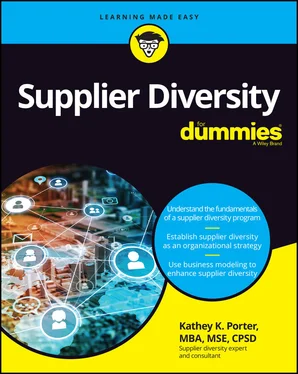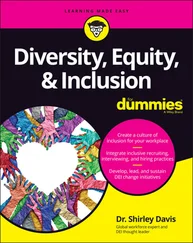Kathey K. Porter - Supplier Diversity For Dummies
Здесь есть возможность читать онлайн «Kathey K. Porter - Supplier Diversity For Dummies» — ознакомительный отрывок электронной книги совершенно бесплатно, а после прочтения отрывка купить полную версию. В некоторых случаях можно слушать аудио, скачать через торрент в формате fb2 и присутствует краткое содержание. Жанр: unrecognised, на английском языке. Описание произведения, (предисловие) а так же отзывы посетителей доступны на портале библиотеки ЛибКат.
- Название:Supplier Diversity For Dummies
- Автор:
- Жанр:
- Год:неизвестен
- ISBN:нет данных
- Рейтинг книги:4 / 5. Голосов: 1
-
Избранное:Добавить в избранное
- Отзывы:
-
Ваша оценка:
- 80
- 1
- 2
- 3
- 4
- 5
Supplier Diversity For Dummies: краткое содержание, описание и аннотация
Предлагаем к чтению аннотацию, описание, краткое содержание или предисловие (зависит от того, что написал сам автор книги «Supplier Diversity For Dummies»). Если вы не нашли необходимую информацию о книге — напишите в комментариях, мы постараемся отыскать её.
Supplier Diversity For Dummies,
Supplier Diversity For Dummies
Supplier Diversity For Dummies — читать онлайн ознакомительный отрывок
Ниже представлен текст книги, разбитый по страницам. Система сохранения места последней прочитанной страницы, позволяет с удобством читать онлайн бесплатно книгу «Supplier Diversity For Dummies», без необходимости каждый раз заново искать на чём Вы остановились. Поставьте закладку, и сможете в любой момент перейти на страницу, на которой закончили чтение.
Интервал:
Закладка:
The global COVID-19 pandemic, polarizing politics, and social justice movements have made diversity, equity, and inclusion (DEI) a high-trending theme and one of the hottest topics in organizations today. You hear about it everywhere: on the news, in company press releases, and in everyday conversations. According to research by management consultancy Russell Reynolds Associates, the hiring of chief diversity officers for companies listed on the S&P 500 nearly tripled from December 2020 to March 2021.
That organizations have recommitted themselves to ensuring that their environments are diverse and inclusive is certainly great news. However, organizations must also remember that they can’t have a fully actualized diversity strategy if it doesn’t include all facets of diversity: the workforce and its suppliers — a side that is sometimes overlooked.
This chapter discusses the differences between supplier diversity and DEI, why they’re collaborative partners, and the pitfalls of combining the two.
Surveying the Programs’ Similar Names and Mission
Since the 20th century, groups have long advocated for equal and fair treatment in the workplace. If you do any research on when diversity became part of the conversation, you find that, like suppler diversity, it has had many iterations over the years to arrive where it is today.
Starting with diversity
As I explain in Chapter 2, calls to address diversity began in the 1960s, when the postwar prosperity still hadn’t reached all segments of society. This disparity inspired unrest and new demands for equality and economic access within the Black community.
President Kennedy first introduced affirmative action legislation in 1961, a method of rectifying discrimination that had persisted despite civil rights laws and constitutional guarantees. It focused on education and jobs and required companies to take active measures to ensure that Blacks and people from other marginalized groups enjoyed the same opportunities for promotions, salary increases, career advancement, school admissions, scholarships, and financial aid that had been nearly exclusively reserved for whites. It was designed as a temporary remedy that would end after a level playing field for all Americans had been attained.
The Civil Rights Act of 1964 signed by President Lyndon Johnson prohibited employment discrimination based on race, sex, color, religion, and national origin and gave rise to the creation of the Equal Employment Opportunity Commission (EEOC) to enforce Title VII and eliminate unlawful employment discrimination. As discrimination in the workplace persisted, the Equal Opportunity Commission (EEOC) set guidelines focused on the culture-at-large and made it a lawful offense. Their goal was to make sweeping changes in the U.S. workplace culture and address how to expand the workforce to include “historically underrepresented populations.”
Most historians agree diversity initiatives began in earnest because of a report during the late 1980s. The report indicated that “only 15 percent of the new entrants to the labor force over the next 13 years will be native white males, compared to 47 percent in that category today,” and that for the United States to keep thriving, lawmakers needed to address three things:
“Maintain the dynamism of an aging workforce” (In other words, ensure that the workforce is able to stay active and engaged.)
Address the “conflicting needs of women, work, and families”
“Integrate Black and Hispanic workers fully into the economy”
This realization really hit home, especially within the business community. The 1980s were a formative decade in history. The United States was trying to reestablish itself as a global power, especially compared to other up-and-coming economies such as China. Diversity initiatives became an important piece to advance the U.S. workforce, expand industry, and maintain America’s global dominance.
During this time, an increasing number of corporations launched diversity initiatives. They focused largely on recruitment and getting workers of different backgrounds in the door. However, they soon found that they had no guarantee those workers would stay.
Introducing inclusion
Constant employee turnover created a revolving door that not only became costly but also created some questions about the organizations’ commitment to diversity. Some companies realized they needed to focus on the working environment just as much — that inclusion needed to be another prong of the strategy. The field became diversity and inclusion.
Inclusion isn’t just superficial recruitment diversity or celebrating differences. It examines how employees can feel accepted for being themselves while having access to the decision making table. Some inclusion strategies include the following:
Business and employee resource groups (ERGs)
Formal mentoring programs
New methods of engaging and leveraging all employees’ knowledge and skills
More transparent paths for employees to succeed within a company and the leadership structure
Expanding for equity
In recent years, diversity and inclusion initiatives have expanded to include equity. Equity focuses on ensuring that everyone has just and fair access to the same information, opportunities, and environment regardless of their experience or specific social position. Each person has unique needs, advantages, and barriers; everyone starts from a different place, so everyone needs different resources to level the playing field. To be successful, inclusive environments require equal access and fairness. Equity enhances inclusion and looks at systemic issues that allow inequality to continue.
 If this sounds a lot like supplier diversity, you’re right. Whether you’re talking about employees or vendors, diversity on its own isn’t enough. To leverage both strategies to drive bottom-line results, the goal is to recruit desired groups to the organization, to create and foster an inclusive environment where they feel welcomed and like a valued part of the culture or process, and to ensure they have equitable access to the same opportunities as everyone else.
If this sounds a lot like supplier diversity, you’re right. Whether you’re talking about employees or vendors, diversity on its own isn’t enough. To leverage both strategies to drive bottom-line results, the goal is to recruit desired groups to the organization, to create and foster an inclusive environment where they feel welcomed and like a valued part of the culture or process, and to ensure they have equitable access to the same opportunities as everyone else.
A NEW SENSE OF URGENCY: PUTTING THE FOCUS ON SUPPLIER DIVERSITY AFTER THE GLOBAL PANDEMIC
I started this project when the world was facing some of the most unparalleled and disruptive events in history — the COVID-19 pandemic and the social unrest sparked by the murder of George Floyd. The world as we knew it came to a halt, with businesses and schools closing and operations shifting to a virtual environment. Groups used this time not only to protest for social reforms but also to demand access to increased economic opportunities.
The death toll from the global pandemic was devastating with the effects still being felt. From an economic perspective, some businesses were able to adapt to this shift to virtual, work-from-home orders, or limited staff. Many, particularly small and diverse businesses, were not and were among the hardest hit. According to CBS News: “There were more than 1 million black-owned businesses in the U.S. at the beginning of February 2020, according to research from the University of California at Santa Cruz, which drew from census survey estimates. By mid-April, 440,000 black business owners had shuttered their company for good — a 41 percent plunge. By comparison, 17 percent of white-owned businesses closed during the same period, the UC Santa Cruz research shows.”
Читать дальшеИнтервал:
Закладка:
Похожие книги на «Supplier Diversity For Dummies»
Представляем Вашему вниманию похожие книги на «Supplier Diversity For Dummies» списком для выбора. Мы отобрали схожую по названию и смыслу литературу в надежде предоставить читателям больше вариантов отыскать новые, интересные, ещё непрочитанные произведения.
Обсуждение, отзывы о книге «Supplier Diversity For Dummies» и просто собственные мнения читателей. Оставьте ваши комментарии, напишите, что Вы думаете о произведении, его смысле или главных героях. Укажите что конкретно понравилось, а что нет, и почему Вы так считаете.












